Raymond Depardon – David Burnett September in Chile,1971/1973
- Exposition
- Exposition
- Location Galerie le Château d'Eau
-
Public
- Tout Public
- Tout Public
It was on the first anniversary of the election of President Salvador Allende in 1971 that Raymond Depardon discovered Chile, accompanied by his friend Robert Pledge, the editorial secretary of Zoom magazine.
In 1973, the American David Burnett covered General Pinochet's coup d'état, which plunged the country into a bloody military dictatorship. From the seizure of the Moneda Palace to Neruda's funeral, his images, along with those of Depardon, made up a collective report, which won the Robert Capa Gold Medal in New York, the highest distinction in photojournalism.
Photographs, originally intended for the press
On the afternoon of 11 September 1973, Chilean military aircraft bombed the Presidential Palace of La Moneda in Santiago and the army took over the seat of power. The socialist President Salvador Allende refused to surrender to the putschists and committed suicide after three years of a left-wing regime that had represented great hope in the country, among peasants and the working class for example, and throughout a continent accustomed to military coups and violence often manipulated by the United States. General Pinochet’s dictatorship was in place and lasted until 1990, accompanied by human rights abuses, 3,200 deaths and “disappearances”, and around 38,000 people tortured. Several thousand people, perhaps a million, went into exile.
Two years earlier, in 1971, Raymond Depardon, a young reporter with the Gamma agency, of which he had been one of the founders a few years earlier, came to Chile to mark the first anniversary of the victory of the People’s Union. He was accompanied by his friend, the journalist Robert Pledge, who worked with Zoom magazine at the time. In addition to a meeting with President Allende, he focused mainly on the world of the peasants, in which he found echoes of his origins.
In September 1973, David Burnett, a reporter for Gamma New York who had just signed a contract with Life magazine and who later joined the Contact Press Images agency when Robert Pledge set it up in New York in 1976, covered the aftermath of the coup d’état in difficult conditions. Arrests, detainees marching to the National Stadium – where they were tortured and executed – book burning, the huge cemetery where the victims are buried, the funeral of poet Pablo Neruda, who died twelve days after the coup – and who is increasingly thought to have been poisoned – he chronicled the beginnings of what was to become a bloody dictatorship.
These photographs, which were originally intended for the press and the news industry alone, are now historical documents, and part of our memory. They also bear witness to the aesthetics of the journalistic image at a time when photography was dominant and decisive for the press. That’s also why we felt it necessary to present the different print runs, those that were distributed to newspapers in the past, and those that are now used for the exhibition and the book.
Christian Caujolle, Artistic Advisor
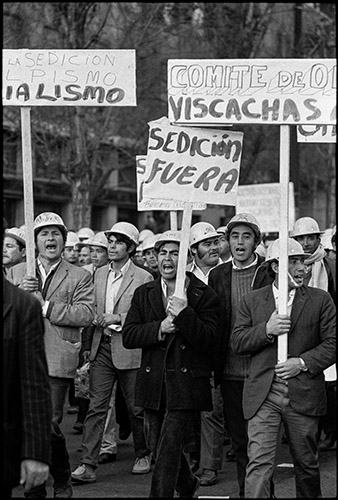
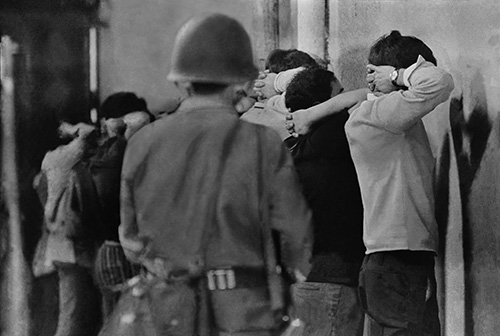
Text of Luis Poirot, extract of ” September in Chile “,1971/1973 », Atelier EXB
SEPTEMBER 1971, Raymond Depardon
Chile, where I was born in 1940, was for many years until 1970 a country where we who lived there used to say: “Nothing happens here”, looking towards Europe or the United States, impatient to see what was happening elsewhere. Our long territory resembled a place of exile from which we had to escape.
Suddenly, Allende arrived and changed everything: the rest of the world turned its attention to us. Intellectuals and journalists came to see and try to understand what this unique experience of socialism combined with freedom was all about. Those of us who lived here were no longer thinking of leaving.
It was at this time that Robert Pledge and a silent photographer with wide surprised eyes arrived. Like many visitors, the latter photographed the great social theatre of the streets of Santiago, occupied for the first time by workers and peasants in a great song of hope and joy. But there was something different about this photographer. He wanted to visit the remote territories of the south, the territories of the Mapuche Indians and landless peasants, ignored for decades by our centralising culture.
I discovered through his images a country I didn’t know when I was in exile in Paris after the coup d’état, and today I can establish a relationship between these photographs and those that Raymond Depardon took years later in France, in equally remote territories. These distant photographs from 1971 were the prologue to a vision that was now visiting the land of his ancestors, a culture ignored by city dwellers here and elsewhere, past and present. Like Paul Strand who, after years of travelling the world, told us that everything he was looking for was right on his doorstep. So when Raymond Depardon visited us in 1971, silent with wide surprised eyes, he was already looking for his inner world, the world that great photographers photograph.
SEPTEMBER 1973, David Burnett
As soon as the coup d’état took place, the military tried to control all information, particularly photographic and cinematographic images. They systematically destroyed the archives of the major publishers and media that had recorded Chile’s social, political and cultural life since 1900, as well as the Chile Films press and documentaries, which were at the origin of a renaissance in national cinema. Only photographers approved by them, who had to wear an accreditation around their neck and an identification bracelet on their sleeve, were allowed to work in the street. To show oneself otherwise with a camera was to risk being reported to the patrols that roamed the city. The news was all word of mouth. I learned of the death of President Salvador Allende on the night of September 11, from an Argentinian radio station; the murder of singer Victor Jara almost a month later and the death of Pablo Neruda in a short paragraph published among other news items, with no details of his funeral.
The military wanted to write a history about Chile that would have begun with them on September 11, and stay silent about everything that had preceded them. They certainly imagined that foreign photographers like David Burnett would give an exemplary vision of the army. But David could only take up the legacy of Robert Capa who stood by the Republic during the Spanish Civil War, that of W. Eugene Smith with the unfortunate people of the world, and respect the memory of August Sander who stood by those persecuted by Nazism, and all the photographers who gave a voice to those whom the authorities wanted to silence.
David and his incorruptible memory have become our own: the systematic abuse of power and violence, the despair of relatives waiting for news at the gates of a stadium, the cemetery alleys filled with anonymous graves, and an act of resistance, perhaps the first, the funeral of poet Pablo Neruda surrounded by soldiers. Nevertheless, the participants sang the national anthem and the “Internationale”, and his friend, the poet Francisco Coloane, recited: “You are not dead, you are not dead, because flowers do not die in spring”. He photographed all this for us, for Chilean photographers, who could not be witnesses to our history.
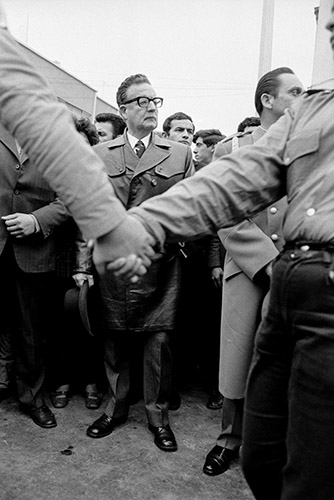
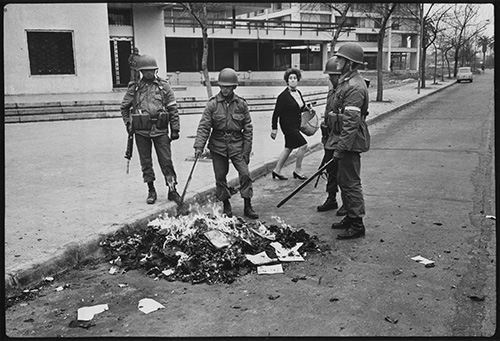
Raymond Depardon
Raymond Depardon was born in Villefranche-sur-Saône in 1942. He took his first photographs on the family farm in Le Garet. At the age of 17, he was a freelancer with Dalmas, a photojournalism agency that covered all areas of current affairs. In 1966, he co-founded the Gamma agency, and was soon joined by Gilles Caron. During a report in Prague in 1969, he made his first short film (Ian Palach) and the following year took his first trip to Chad with Caron and Robert Pledge. In 1971, he travelled with Salvador Allende to Chile, where they met Luis Poirot. An adept of “direct cinema”, he filmed Valéry Giscard d’Estaing’s presidential campaign (1974, une partie de campagne), featuring David Burnett, who was covering the campaign for Time magazine. In 1978, he joined the Magnum agency, leading a life as a photographer and a career as a documentary filmmaker. La vie moderne, the third part of “Profils paysans”, was awarded the Prix Louis Delluc (Louis Delluc Prize) in 2008. His images have appeared in numerous books accompanied by exhibitions, most recently Son œil dans ma main, Algérie 1961-2019 (Algeria 1961-2019), a cross-view with writer Kamel Daoud, presented in 2022 at the Institut du monde arabe (Arab World Institute) in Paris.
David Burnett
David Burnett was born in Salt Lake City in Utah, United States, in 1946. He has a degree in political science from Colorado College. From 1970 to 1972, he covered the Vietnam War on a freelance basis for Time and then Life magazine. He joined the Gamma agency in 1973, photographing the aftermath of the military coup in Chile and sharing with Raymond Depardon and Chas Gerretsen the Robert Capa Gold Medal awarded by the Overseas Press Club of America (OPC) for their book “Chile”. For 50 years, he produced reports in 80 countries, covering thirteen Summer Olympics since 1984. His images have been exhibited at the Arles, Perpignan and Pingyao festivals, and in museums, galleries and cultural institutions in Europe, Australia, Japan, China and the United States. Winner of numerous awards, including the Philippe Halsman Award for his “contribution to photojournalism”, presented by the ASMP (American Society of Media Photographers) in 1986, and the Sprague Award for lifetime achievement, presented by the NPPA (American Press Photographers Association) in 2018. He co-founded the Contact Press Images agency in New York with Robert Pledge in 1976.
Leopoldo Victor Vargas
Leopoldo Victor Vargas, born in 1933 in Putaendo, province of San Felipe, Chile, died in 2011 He joined the newly created aerial photography section of the Chilean Air Force (Fuerza Aérea de Chile) at an early age, from which he graduated in 1954. He was a Non-Commissioned Officer and was the only permanent military photographer attached to the Presidential Palace at La Moneda from 1964 to 1973. He held this position during the terms of office of Presidents Jorge Alessandrini, Eduardo Frei and Salvador Allende, before resuming his work as an aerial photographer in the Air Force’s photogrammetry service in 1974, at his own request.
La presse en parle
-

Trois ans après son accession au pouvoir à la suite d’élections démocratiques, le président socialiste, Salvador Allende, est renversé par le général Pinochet. Retour sur les photographies d’un coup d’Etat qui jettera une onde de choc dans le monde entier.
Read the publication -

Allende, les paysans en lutte, le coup d’état : Le Chili en 1971-1973 à travers l’objectif de Depardon et Burnett
Read the publication -
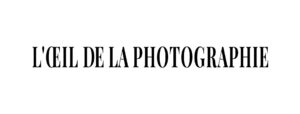
A l’occasion du cinquantenaire du coup d’état du Général Pinochet contre le gouvernement populaire d’Allende, la galerie Le Château d’Eau de Toulouse réunit les deux reportages réalisés par Raymond Depardon et David Burnett, au Chili à 3 ans d’intervalle.
Read the publication -

Dans l’œil de Libé
Read the publication
EN IMAGES – «Septembre au Chili 1971-1973», par Depardon et Burnett -

David Burnett: « Je n’oublierai jamais les cris des gens battus dans le Stade national de Santiago »
Read the publication

